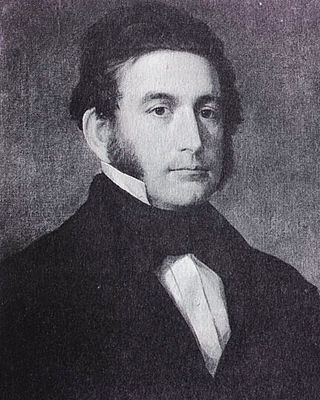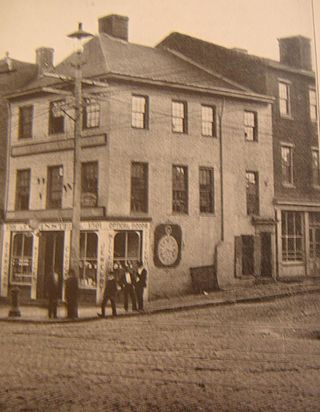
Edgar Allan Poe was an American writer, poet, editor, and literary critic who is best known for his poetry and short stories, particularly his tales involving mystery and the macabre. He is widely regarded as one of the central figures of Romanticism and Gothic fiction in the United States, and of early American literature. Poe was one of the country's first successful practitioners of the short story, and is generally considered to be the inventor of the detective fiction genre. In addition, he is credited with contributing significantly to the emergence of science fiction. He is the first well-known American writer to earn a living by writing alone, which resulted in a financially difficult life and career.

William Evans Burton was an English actor, playwright, theatre manager and publisher who relocated to the United States.

"The Gold-Bug" is a short story by American writer Edgar Allan Poe published in 1843. The plot follows William Legrand, who becomes fixated on an unusual gold-colored bug he has discovered. His servant Jupiter fears that Legrand is going insane and goes to Legrand's friend, an unnamed narrator, who agrees to visit his old friend. Legrand pulls the other two into an adventure after deciphering a secret message that will lead to a buried treasure.

"The Fall of the House of Usher" is a short story by American writer Edgar Allan Poe, first published in 1839 in Burton's Gentleman's Magazine, then included in the collection Tales of the Grotesque and Arabesque in 1840. The short story, a work of Gothic fiction, includes themes of madness, family, isolation, and metaphysical identities.

The Narrative of Arthur Gordon Pym of Nantucket, written in 1838, is the only complete novel by American writer Edgar Allan Poe. The work relates the tale of the young Arthur Gordon Pym, who stows away aboard a whaler called the Grampus. Various adventures and misadventures befall Pym, including shipwreck, mutiny, and cannibalism, before he is saved by the crew of the Jane Guy. Aboard this vessel, Pym and a sailor named Dirk Peters continue their adventures farther south. Docking on land, they encounter hostile, black-skinned natives before escaping back to the ocean. The novel ends abruptly as Pym and Peters continue toward the South Pole.

Rufus Wilmot Griswold was an American anthologist, editor, poet, and critic. Born in Vermont, Griswold left home when he was 15 years old. He worked as a journalist, editor, and critic in Philadelphia, New York City, and elsewhere. He built a strong literary reputation, in part due to his 1842 collection The Poets and Poetry of America. This anthology, the most comprehensive of its time, included what he deemed the best examples of American poetry. He produced revised versions and similar anthologies for the remainder of his life, although many of the poets he promoted have since faded into obscurity. Many writers hoped to have their work included in one of these editions, although they commented harshly on Griswold's abrasive character. Griswold was married three times: his first wife died young, his second marriage ended in a public and controversial divorce, and his third wife left him after the previous divorce was almost repealed.

The Southern Literary Messenger was a periodical published in Richmond, Virginia, from August 1834 to June 1864, and from 1939 to 1945. Each issue carried a subtitle of "Devoted to Every Department of Literature and the Fine Arts" or some variation thereof and included poetry, fiction, nonfiction, reviews, and historical notes. It was founded by Thomas Willis White, who served as publisher and occasional editor until his death, in 1843.

Graham's Magazine was a nineteenth-century periodical based in Philadelphia established by George Rex Graham and published from 1840 to 1858. It was alternatively referred to as Graham's Lady's and Gentleman's Magazine, Graham's Magazine of Literature and Art, Graham's American Monthly Magazine of Literature and Art, and Graham's Illustrated Magazine of Literature, Romance, Art, and Fashion.

George Rex Graham was an American magazine editor and publisher from Philadelphia, Pennsylvania. He founded the journal Graham's Magazine at the age of 27 after buying Burton's Gentleman's Magazine and Atkinson's Casket. His journal became very popular and it was known for its generous payment to contributors.

The Stylus, originally intended to be named The Penn, was a would-be periodical owned and edited by Edgar Allan Poe. It had long been a dream of Poe to establish an American journal with very high standards in order to elevate the literature of the time. Despite attempts at signing up subscribers and finding financial backers and contributors, the journal never came to be.
The Broadway Journal was a short-lived New York City-based newspaper founded by Charles Frederick Briggs and John Bisco in 1844 and was published from January 1845 to January 1846. In its first year, the publication was bought by Edgar Allan Poe, becoming the only periodical he ever owned, though it failed after only a few months under his leadership.
This article lists all known poems by American author and critic Edgar Allan Poe, listed alphabetically with the date of their authorship in parentheses.
"Morella" is a short story in the Gothic horror genre by 19th-century American author and critic Edgar Allan Poe.

The American Review, alternatively known as The American Review: A Whig Journal and The American Whig Review, was a New York City-based monthly periodical that published from 1844 to 1852. Published by Wiley and Putnam, it was edited by George H. Colton, and after his death, beginning with Volume 7, by James Davenport Whelpley. As of Volume 10, July 1849, the proprietors of the journal were Whelpley and John Priestly. The American Review was allied to the Whig Party.

Tales of the Grotesque and Arabesque is a collection of previously published short stories by Edgar Allan Poe, first published in 1840.

Nathan Covington Brooks was an American educator, historian, and poet. Born in West Nottingham, Cecil County, Maryland, Brooks grew up to become the first principal of Baltimore City College, the third oldest public high school in the United States, and the only president of the Baltimore Female College, the first institution of higher education for women in Maryland. He also was the owner of the literary magazine The American Museum in which he published several works of the famed poet Edgar Allan Poe, and the author of several textbooks on classical literature. Brooks died in Philadelphia, Pennsylvania.

Thomas Dunn English was an American Democratic Party politician from New Jersey who represented the state's 6th congressional district in the House of Representatives from 1891 to 1895. He was also a published author and songwriter, who had a bitter feud with Edgar Allan Poe. Along with Waitman T. Barbe and Danske Dandridge, English was considered a major West Virginia poet of the mid 19th century.

George Pope Morris was an American editor, poet, and songwriter.

The works of American author Edgar Allan Poe include many poems, short stories, and one novel. His fiction spans multiple genres, including horror fiction, adventure, science fiction, and detective fiction, a genre he is credited with inventing. These works are generally considered part of the Dark romanticism movement, a literary reaction to Transcendentalism. Poe's writing reflects his literary theories: he disagreed with didacticism and allegory. Meaning in literature, he said in his criticism, should be an undercurrent just beneath the surface; works whose meanings are too obvious cease to be art. Poe pursued originality in his works, and disliked proverbs. He often included elements of popular pseudosciences such as phrenology and physiognomy. His most recurring themes deal with questions of death, including its physical signs, the effects of decomposition, concerns of premature burial, the reanimation of the dead, and mourning. Though known as a masterly practitioner of Gothic fiction, Poe did not invent the genre; he was following a long-standing popular tradition.

William Croome (1790–1860) was an American illustrator and wood engraver in the 19th century. He trained with Abel Bowen in Boston, Massachusetts. Croome's work appeared in the American Magazine of Useful and Entertaining Knowledge (1830s), Lady's Annual (1830s), Crockett Almanac (ca.1840s), and in numerous children's books.


















